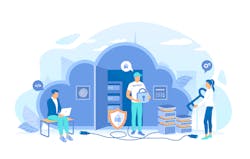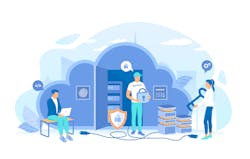Backup and encryption, endpoint detection and response, next-generation firewalls, penetration testing…the list goes on and on. How many tools and vendors do you really need to keep your company safe?
In mid-2022, Gurucul surveyed the RSA Conference and revealed that 43% of experts agree on one thing: an overabundance of tools is the number one challenge they face in threat detection and remediation. Unfortunately, having too many security tools is not a recent issue.
Two years ago, IBM was already uncovering the problem. The organization reported that organizations were using more than 45 different security tools on average. When an attack happened, the same organizations had to coordinate the response around 19 security solutions.
While it's understandable that organizations will step up their security investments as cyber threats continue to increase, the question needs to be asked: When do too many security solutions become not just a money and management problem, but a risk to your networks? Let's dive into three simple but cost-effective strategies to increase your security.
Make the Most of Your Built-In Cloud Security Features
If you have not migrated to the cloud yet, you should consider doing so to simplify your data storage and drop IT costs and access innovation services like AI applications and data analytic dashboards. Additionally, cloud providers have built-in security services that are highly effective and have no extra cost.
If you already work in the cloud, whether on Microsoft Azure, Google Cloud, or Amazon Web Services (AWS), you should go to your security settings and turn on every feature available. All cloud providers today are trying to differentiate themselves from the competition by providing state-of-the-art technology, services, and innovations. When you are accessing cloud services, you are benefiting from the competition that big tech cloud providers have among each other.
For example, the Microsoft Defender for Cloud is an integrated cloud-native application solution for both hybrid and multi-cloud environments. This means you can use it even if your use on-premise data centers or spread your IT throughout different cloud providers.
Furthermore—like Google Cloud or AWS—Microsoft offers threat intelligence, AI, and automated security tools that are constantly updated to keep your data, applications, and system safe at all times. Most of all, these services are completely free.
You can access the latest in security, and also skill your workers with cloud resources provided by your vendors. Cloud security can help you respond efficiently to the ever-evolving threat landscape.Mix It Up With Cloud And Edge Computing
Edge computing has many benefits. In the simplest of terms, edge computing is all about bringing the data as close to the user as possible. How does edge computing help boost your security? Edge computing and IoT devices store data in the hardware, not in software cloud systems or on the web. And hacking hardware is infinitely more difficult than hacking software.
Organizations need instant and live data processing capabilities to work. For example, retailers use edge computing to drive real-time digital sales across different locations without going through the cloud, or smart cities use the edge to power camera systems for traffic management and security.
The edge doesn’t just help your security, organizations using edge computing store data and process it on-site, on devices, or in edge data centers. Data can move rapidly through 5G networks, providing the much-needed low-latency (no delay) capabilities required for live-data processing.
The edge can also cut your IT costs. Sending data to cloud providers that can be several hundred or thousands of miles away can not only be expensive but can generate reliability and delay problems. By combining edge with cloud, you can get the best of both worlds: the speed, agility, and security of the edge and the power of the cloud, its innovations, AI, and threat mitigation features.
Data and Security Management Frameworks
Overlapping security solutions is not only a problem from a budget perspective. It creates issues with visibility, errors, and misconfigurations. Verizon’s 2022 Data Breach Investigations Report says that errors and misconfiguration are the second top group of vectors responsible for breaches after web applications and email phishing.
Additionally, a Keysight survey revealed that more than half (66%) of organizations admit their security solutions overlap functionality. How can security teams keep good quality data, and make sure their security solutions are not overlapping? The answer is data and security management frameworks.
It's important to understand that security solutions are simply a tool that is used within a much broader program. Companies that excel in data security also excel in data quality and data management; this not only strengthens their security posture but drives their performance as data-driven companies. These frameworks also help meet compliance, governance, and regulations.
Integral data and security management frameworks are holistic approaches that will create a strong data culture across the organization and set data and security goals aligned with your business priorities and targets. The framework defines roles and responsibilities, empowers data leaders, and drives data processes. Technology is the final layer of data management frameworks, not the first. Always start with choosing the right people; they will build the processes and inform you about the technology needed to get the job done.
Cybersecurity doesn't always take a village. Going even further, a village in cybersecurity can theoretically cause severe damage to your organization. Focusing on the three strategies outlined (cloud, edge, and data management frameworks) will keep your budget in control, increase your performance, and open new doors for your company. In security, less can definitely be more.
Eden Data is on a mission to break the outdated mold of traditional consulting in the cybersecurity space. Hanson started his career at Deloitte where he advised Fortune 500 companies on compliance and security tactics. From there, he took a role as a Chief Information Security Officer (CISO) for a local firm where he was not only responsible for building an entire security program from the ground up but was also one of the youngest executive-level security officers in the industry. He currently serves as the security thought leader for multiple organizations globally, managing his professional and personal brand through two founded companies: Eden Data and Millennial CISO, and additionally as CompTIA’s first-ever Cybersecurity Advisory Council on the Board.
About the Author

Taylor Hersom
CEO and Founder of Eden Data
Taylor Hanson is the CEO and Founder of Eden Data, a cybersecurity firm that focuses on the next generation of businesses that are ready to build security and privacy into their DNA, from their culture and technologies to their entire operating processes. Taylor and his team build world-class security programs for organizations that not only want to embrace cybersecurity but want to realize the benefits of putting data privacy first, from brand recognition to customer loyalty, while realizing substantial ROI. Hanson’s keen understanding of cybersecurity and compliance as it relates to the next generation of companies, who are predominantly de-centralized and cloud-centric, assists in building cybersecurity programs that work for them.
Eden Data is on a mission to break the outdated mold of traditional consulting in the cybersecurity space. Hanson started his career at Deloitte where he advised Fortune 500 companies on compliance and security tactics. From there, he took a role as a Chief Information Security Officer (CISO) for a local firm where he was not only responsible for building an entire security program from the ground up, but was also one of the youngest executive-level security officers in the industry. He currently serves as the security thought leader for multiple organizations globally, managing his professional and personal brand through two founded companies: Eden Data and Millennial CISO, and additionally as CompTIA’s first-ever Cybersecurity Advisory Council on the Board.


